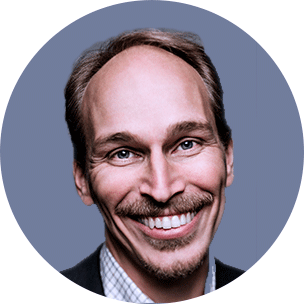
Why vertical development suits today’s complex leadership roles
Finding efficient methods for personal leadership development is important, but not easy. We often choose well-traveled paths, even if they are not always successful. But research shows that the actual framework we choose, given our conditions, is important and can generate benefits on many different levels – not only for the individual, but for the company, employees and customers.

Mats Eklund, who lectures on adult development at the Managing Professional Services (MAPS) program at SSE Executive Education, has immersed himself in vertical development methods, which he believes have advantages and complement other more traditional models.
Higher demands on leaders today
Mats says that personal vertical development is about the ability to create meaning using new strategies that suit the complex world in which we live and work, because it places increasingly high demands on you as both a leader and a person. Indeed, even if we perceive ourselves as adaptive and motivated, changing habitual behaviors is never easy. That doesn’t mean we do not want to grow, but that growth is more complex than we realize. In addition, vertical development shows that we all have different levels of awareness, which improve or limit our ability to understand the world around us and act accordingly.
Adult development is possible throughout life
According to Mats, people have historically thought that we develop as children, and then become adults and stop changing. It is easy to resort to simplified theories that categorize us into four colors, for example, with fixed traits to which we and others adhere – in the worst case, throughout our entire lives.
“I think the triggering factor for introducing vertical development into the Managing Professional Services program was when the most popular book among leaders was entitled ‘Surrounded by Idiots.’ We wanted to stand for something else, both scientifically and in terms of values.”
“Simply put, adult development is possible throughout life. In other words, we aren’t human beings, but human becomings.”
The difference between horizontal and vertical development
Traditional horizontal development entails, in brief, learning to use the strategies you’ve already conquered more efficiently, i.e., ‘more but more versatile’ in one stage, while vertical development involves developing new strategies and thus growing vertically from one stage to the next, i.e., ‘something new and different.’ If traditional horizontal development is about refining what you have already learned, then vertical development is based on transforming what you already know. Both methods should act harmoniously, so the point is not to choose a way in which to grow; rather, it is an expansion of development in and of itself.
Vertical development can be split into seven stages and “types”
- Opportunist – manipulative, self-oriented, short-sighted.
- Diplomat – wants to belong to a group and adhere to norms, good at holding the group together at the office.
- Expert – rational and logical, good at contributing individually to their field of expertise (this is where the largest number of leaders are, 38%, according to the study from Harvard below).
- Achiever – effective through their team, action and goal-oriented.
- Individualist – shifts easily between personal views and corporate logic. Finds unique solutions, good in consulting roles.
- Strategist – handles transformations on both the personal and organizational level, works on all levels in the short and long-term, effective leader during a paradigm shift.
- Alchemist – contributes to social transformations, leads large systemic shifts, can handle complexity on every level.
5 years to go from one level to the next
The list above begins with a lower level in development (Opportunist) and concludes at the bottom with the most evolved level (Alchemist). Transitioning from one level to the next is estimated to take 5-10 years, but it can take more or less time. How far one goes varies from person to person and based on an individual’s conditions and other circumstances, people grow to a certain extent. Only a few reach the last level. Mats explains that we always retain the previous strategies and can use them, for example unwittingly under extreme stress, or actively when a situation requires it.
Leaders who can handle complexity are valuable
Most leaders today are stressed by the world’s state as a fickle, insecure, complex and difficult place to understand. The number of people who manage or perhaps thrive in this uncertain state while still perceiving patterns and having the ability to shift perspectives is limited (only a few percent of our global leaders), but they are also very valuable. Leaders who climb high up the vertical development ladder can generate upwards of three times as much value as weak leaders, while extraordinary leaders generate significantly more value for the company than all the rest (study of 30,000 leaders, Zenger & Folkman, 2009).
Invest, don’t recruit
A company that permits its leaders to grow has much to gain from doing so. Not just because they avoid having to recruit at the highly developed level (58 percent of new leaders who are externally recruited fail within 18 months, according to “Seven Transformations of Leadership” [Harvard Business Review, 2003]), but also because career development is both motivating and appealing to employees. In addition, it can save recruitment costs and erroneous recruitments which can be expensive for the organization.
Mats Eklund explains that personal vertical development in the Managing Professional Services program is about helping participants understand their strategies, the opportunities they have, and how they can continue to grow. The service industry is especially person-dependent and both branding and success often involve finding the right person at the right place, for example out with customers. Understanding your strengths and areas for improvement is therefore especially important in this sector.
Growing as a person, not just a leader
He says the achievement of a high level of development in a leader is indicated through a sense of calm and curiosity. These people are so secure with themselves that they can try on others’ perspectives without feeling that their own sense of the world is threatened. A good example is former Swedish archbishop K.G. Hammar.
Other leaders at a very high leadership level include Warren Buffet and Nelson Mandela. Buffet has evolved throughout his career through perhaps seven different steps, and not only as a leader, but also as a person. Mats offers a concluding example of vertical development.
“Abraham Maslow researched extremely high performers and identified them as people who have realized their full potential. His theory was that if we have good conditions, we live longer, are healthier, have happier marriages and friendships and perform well at work. In other words, not just the latter. The approach is holistic and that’s what we want to convey in the program.”
The Managing Professional Services program is for anyone who wants to grow as a manager and leader in a professional service company, with a focus on guidance and consultation.


